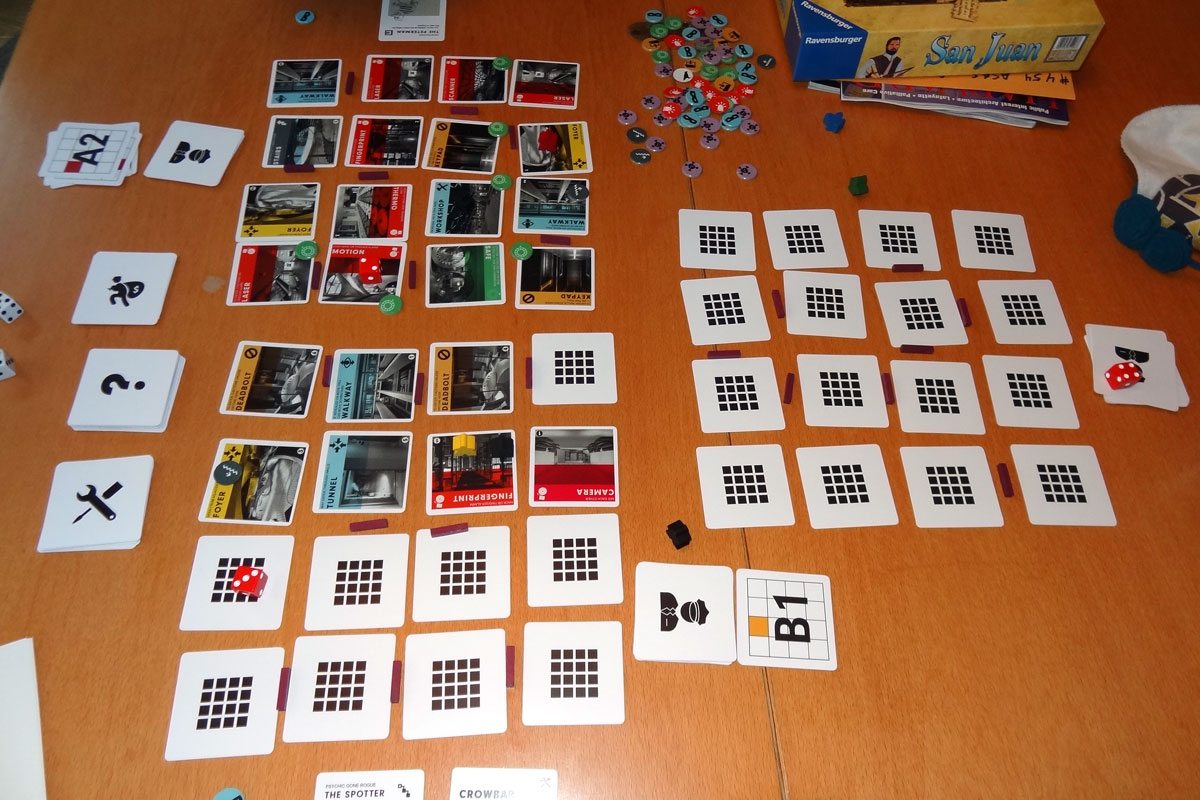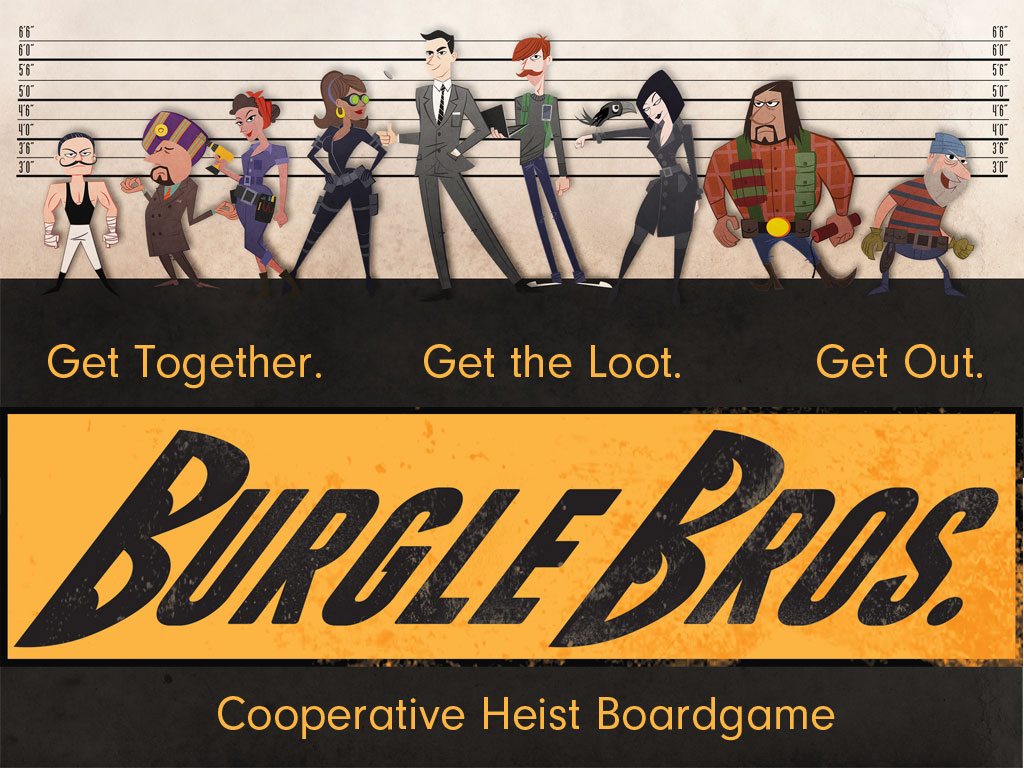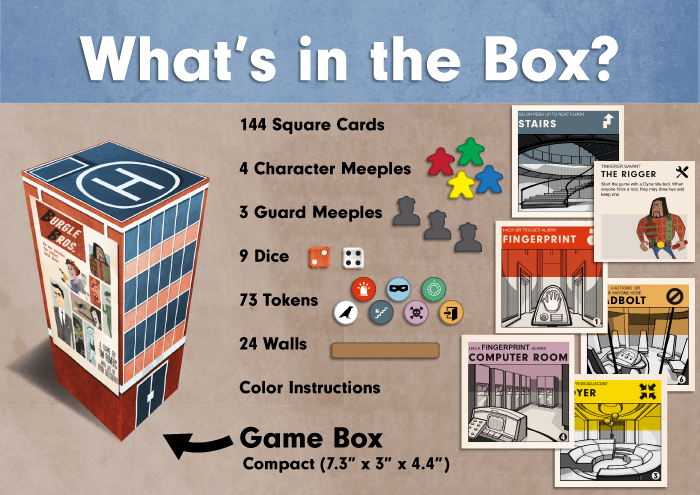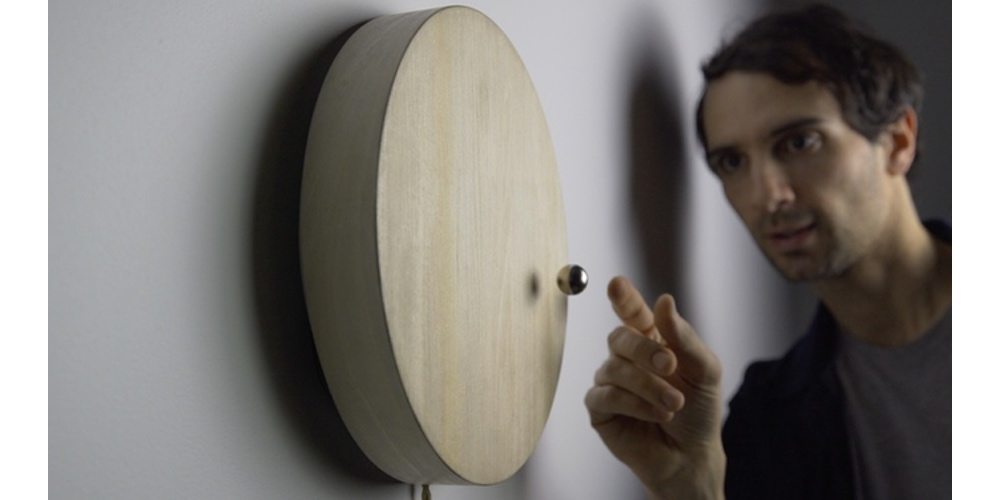Assemble your team, crack the safes, evade the guards, and get out before you’re caught. Welcome to Burgle Bros., a cooperative heist game by Tim Fowers.
At a glance: Burgle Bros. is a cooperative game for 1 to 4 players, ages 12 and up, and takes about an hour to play. (Play time varies depending on setup and number of players.) It’s on Kickstarter now, and a pledge level of $29 gets you a copy of the game. There’s even a $34 pledge level that also gets you a copy of Monaco, a PC heist game that inspired Burgle Bros. The game could probably be played by younger players, as long as you’re okay with them role-playing burglars; the rules of the game aren’t much more complicated than something like Forbidden Desert.
New to Kickstarter? Take a look at our crowdfunding primer.
Components
Burgle Bros. includes:
- 144 cards:
- 48 room cards
- 48 guard patrol cards
- 9 character cards
- 15 tools
- 24 event cards
- 73 tokens:
- 18 Stealth Tokens
- 18 Hacking Tokens
- 18 Cracking Tokens
- 9 Alarm Tokens
- 5 Downstairs Tokens
- 5 Open Tokens
- 1 Crow Token
- 4 Character meeples
- 3 Guard meeples
- 9 six-sided dice
- 24 walls

The cards are all square cards, which works nicely for setting up the rooms as a grid. My demo prototype version had placeholder art, but you can see some samples of the final artwork by Ryan Goldsberry on the Kickstarter page, and even the rooms have been illustrated to match the ’60s vibe like the character designs. I wouldn’t be surprised if the Kickstarter campaign hits the stretch goal to make all the rooms cardboard tiles instead of cards.

How to play
You can read a draft of the rules here.
The object of the game is to crack all the safes and escape the building through the roof without anyone being captured.
There are multiple ways to set up the game, but the default is a 3-story building. Each floor has 16 rooms, laid out in a 4×4 grid with walls placed between some of the rooms. Each floor has one safe room and one stairs room; the rest of the rooms are mixed up.
Each player gets two character cards at random and chooses one. Each player also gets 3 stealth tokens.
Each floor also has a security guard with a corresponding patrol deck, made up of 16 cards, one for each location on the floor. At the beginning of the game, each of these decks is shuffled separately and placed near the floor. Also, the three guard dice are placed on these decks, showing 2, 3, and 4 for the first, second, and third floors, respectively.
Reveal the top card of the patrol deck for the first floor and place the guard in the indicated room. Then, as a group, decide where you would like to enter the first floor. Reveal that room and place all the character meeples in that room. (No effects are triggered in the starting room.) Then, reveal the next patrol card, showing the guard’s first destination. Place the red guard die on that room. You’re ready to begin!
On your turn, you get four actions, which can be spent to look ahead, move, hack computer rooms, and crack safes. If you use 2 or fewer actions, you’ll draw an event, which could be good or bad. Finally, you move the guard on your floor.
Here are some more details: you can spend actions to look at an adjacent room and reveal it–this avoids setting off alarms, but it’s slower. Or, you can just move into an unknown room and reveal it by walking into it, but then you’re taking your chances. You might set off an alarm or fall through a walkway down to the next floor.
There are three computer rooms, tied to different types of alarms. When you’re in a computer room, you may spend actions to add hack tokens to that room. Any time any character would set off the corresponding type of alarm, players may discard hack tokens to cancel the alarm.

Cracking the safe is a little more complicated. The combination for the safe is the numbers on all the rooms that share a column or row with the safe, so you’ll have to reveal those rooms to find the combination. You may spend two actions to add a die to the safe room, or one action to roll all the dice on the room. (Once dice are added, they’re available to roll each time until the safe is cracked.) If you roll a number that matches any of the combination numbers, you can cover those combination tiles with the cracking tokens. Once all the combination numbers are cracked, the safe is open and the player who cracked it gets a tool card.
The guard will always take the shortest route toward its destination–if there’s a tie, it takes the clockwise route. It moves as many spaces as are shown on its die: the guard on the first floor starts at speed 2. However, if any alarms are set off, the guard’s destination changes to the closest alarm, and each alarm currently on the floor increases the guard’s speed by 1 until it is turned off (when the guard reaches that destination). When the guard reaches its destination, you flip over another patrol card to check its next destination, moving the die to that space. If you run out of cards, you reshuffle and permanently increase the speed by 1. (You’ll also discard some of the patrol cards at random if you’re playing with fewer than 4 players.)

If you’re ever in the same space as a guard–whether you entered its space or it entered yours–you must discard a stealth token to hide. If can’t hide, then the guard catches you, you squeal on all your associates, and the game ends in failure.
To win, the team needs to find and crack all three safes, and then find the stairs to the roof and get out.

The Verdict
I love heist movies, and I’ve been looking a long time for a good heist game. What I want is a game that feels like watching Ocean’s 11 or an episode of Leverage: a team of people, all with different strengths, going in and getting past various defenses and security measures to grab the loot. I’ve played a lot of heist-based games, and so far Burgle Bros. is probably the closest I’ve experienced. It’s not perfect, but it’s still a lot of fun.
First, here’s what I liked about it: I really do like the artwork. Ryan Goldsberry has done artwork for Tim Fowers’ other games (Wok Star, Paperback) so it’s familiar, but I particularly liked the way this one turned out.
It has a lot of what I imagine should happen in a heist game: guards that patrol the corridors, laser alarms, keypad locks, hacking computers, and a team of colorful characters with special abilities. I like the unknown building layout that forces you to explore, and particularly the mechanic of “peek” vs. “move.” You can just run through rooms quickly but risk setting off alarms, or peek ahead but move at half the speed–and being too slow can cost you, as well.
Thematically it works pretty well. The rooms and the alarms, for the most part, make sense. Motion detectors go off unless you end your movement there, because you have to slow down. Lasers take an extra action or you set off the alarm. Keypads can be hacked, with a better chance to unlock them the longer you spend at them. The character abilities are also a lot of fun. Whether it’s setting your pet raven to harass the guards or triggering alarms remotely on a floor to send the guard running in the wrong direction, each character has special abilities that can be powerful if used correctly.
It’s cool that the building has multiple floors, too–both just for thematic purposes, but also because of the way you can play the guards by moving to a different floor (thus triggering a different guard and potentially saving one of your teammates who’s in the previous guard’s path). The patrol cards do create a sense of tension when you’re near a guard and don’t know which direction he’ll be heading next–and particularly when he speeds up after the deck is reshuffled.
I though the safe-cracking mechanic was also pretty clever. There are always six rooms to uncover to get the safe’s “combination,” but depending on what rooms are there, you may need six different numbers or you might only need a few. We’ve had some games where every safe ended up with five different numbers, making them harder to crack–and some where we got a lot of duplicates and only needed three different numbers for a safe. The Loot Deck expansion, just unlocked this weekend, will also add some more tricks: each time you crack a safe, the Loot card will give you some special instructions for the next floor, potentially making it harder.
I also like the potential for different room layouts–what about one big floor with multiple guards? How about multiple safes on one floor? Somebody on BoardGameGeek has already suggested a print-and-play add-on using the characters from Leverage.
So, what wasn’t perfect? Well, playing the game can be a little bit fiddly. It’s a lot of cards to set up, with those little walls in between some of the rooms, and moving the guards around can feel tedious sometimes. It’s easy to bump something and fling walls and rooms across the table if you’re not careful, and the game does take up quite a bit of table space.
As with many cooperative games, you can get into an alpha player rut here: that’s when one player takes over and just tells everyone what to do, making the game feel more like watching somebody play solitaire than truly cooperating. There’s no easy way around this problem other than just pointing it out when it happens and trying to encourage everyone to give their input on what should happen next.
I did wish we got to use more tools, too. There are two Workshop rooms that have tools in them, and each time you open a safe you get one. That’s only five tools you get to play with per game (plus one more if you get the MacGyver event), and that’s assuming you find both Workshops. For a game about a heist, it’s surprising not to have more fun gadgets at your disposal. You know, drugged meat for the guard dogs, the femme fatale who distracts the guard, the mirror that lets you peek around a corner.
Probably my biggest complaint, though, is that it felt too easy. I’ve played with two, three, and four players, and I’ve won every single time. For a cooperative game, that’s unusual. I’ve heard a rule of thumb that if you’re designing a cooperative game, you want people to win about a third of the time–more than that, and it doesn’t feel like a challenge; less than that, and people might give up. (Though there are exceptions to that rule, of course.)
Granted, the Loot expansion will increase the difficulty, and you could also easily scale things up by starting the guards at a faster speed or reducing the number of stealth tokens each player starts with. But it does feel too easy if I win every time.
That said, I’ve enjoyed playing Burgle Bros. anyway, and there have been some tense moments even in the times we’ve won. There have been close calls and perfectly-timed distractions, blowing up walls and hiding in laboratories. If you’re looking for a fun heist game and don’t mind tweaking the difficulty yourself, Burgle Bros. might be just the loot you’ve been looking for.
For more information, check out the Kickstarter page.
Disclosure: I received a demo prototype of this game for review purposes.







Jonathan, any thoughts on how to amp up the game’s difficulty?
So I’ve been told that the Loot Deck will increase the difficulty. I think the two quickest ways to increase the difficulty are to start with fewer Stealth tokens per player, and to increase the starting speed of the three guards. Doing one or the other (or both) will certainly make it harder without significantly altering the rules.
The other, mentioned in the rulebook, is to change the setup of the walls. There’s a suggested layout for first, second, third floor, but you can create your own. More dead ends makes it harder—more loops and open spaces is easier.
The easiest way is to reduce the number of stealth tokens. We screwed up the rules and effectively played with only two each. We lost three of three games on just the two floor office job. The last one was VERY close, though.